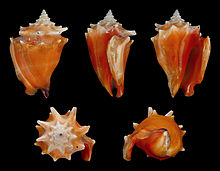Strombus
|
Strombus Temporal range: Cretaceous - Recent |
|
|---|---|
 |
|
| Five views of a shell of the West Indian fighting conch, Strombus pugilis, type species of the genus Strombus | |
| Scientific classification | |
| Kingdom: | Animalia |
| Phylum: | Mollusca |
| Class: | Gastropoda |
| (unranked): | clade Caenogastropoda clade Hypsogastropoda clade Littorinimorpha |
| Superfamily: | Stromboidea |
| Family: | Strombidae |
| Genus: |
Strombus Linnaeus, 1758 |
| Type species | |
|
Strombus pugilis Linnaeus, 1758 |
|
| Species | |
|
See text |
|
| Synonyms | |
|
|
See text
Strombus is a genus of medium to large sea snails, marine gastropod molluscs in the family Strombidae, which comprises the true conchs and their immediate relatives. The genus Strombus was named by Swedish Naturalist Carl Linnaeus in 1758. There were around 50 living species recognized, which vary in size from fairly small to very large. Six species live in the greater Caribbean region, including the queen conch, Strombus gigas (now usually known as Eustrombus gigas or Lobatus gigas), and the West Indian fighting conch, Strombus pugilis. However, since 2006, many species have been assigned to discrete genera. These new genera are however not yet found in most textbooks and collector's guides.
Worldwide, several of the larger species are economically important as food sources; these include the endangered queen conch which very rarely also produces a pink, gem quality pearl.
In the geological past, a much larger number of species of Strombus existed. Fossils of species within this genus have been found all over the world in sediments from Cretaceous to Quaternary (age range: 140.2 to 0.0 million years ago).
Of the living species, most are in the Indian and Pacific Oceans. Many species of true conchs live on sandy bottoms among beds of sea grass in tropical waters. They eat algae and have a claw-shaped operculum.
Like almost all shelled gastropods, conches have spirally constructed shells. Again, as is normally the case in many gastropods, this spiral shell growth is usually right-handed, but on very rare occasions it can be left-handed.
...
Wikipedia
